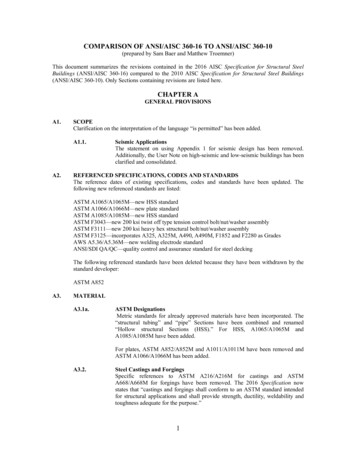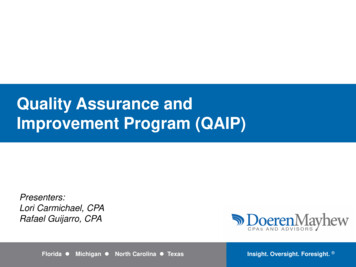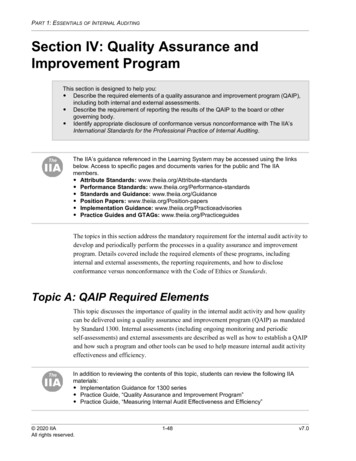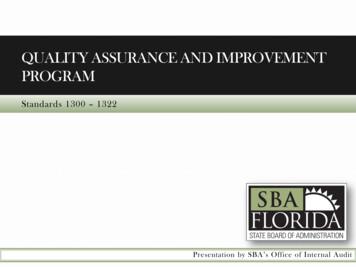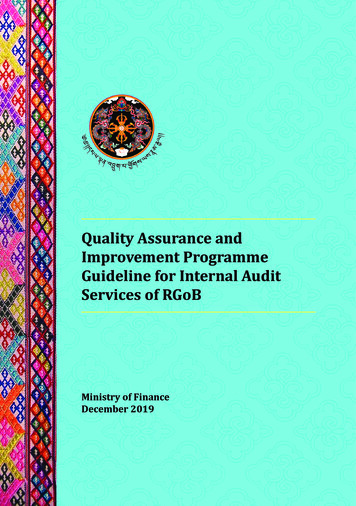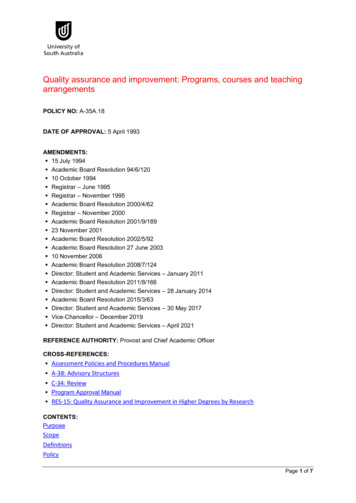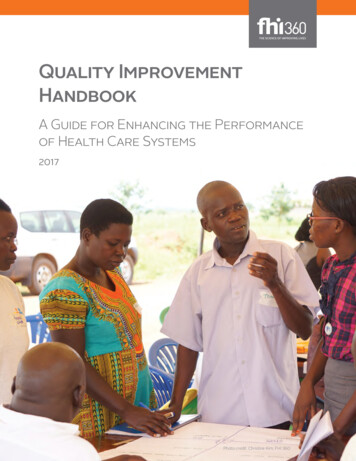
Transcription
Quality ImprovementHandbookA Guide for Enhancing the Performanceof Health Care Systems2017Photo credit: Christine Kim, FHI 360
Nilufar Rakhmanova, MD, MPH, Quality Improvement Advisor, FHI 360Bruno Bouchet, MD, MPH, Director of the Health Systems Strengthening Division, FHI 360 2017 FHI 360
Quality Improvement HandbookAbout This HandbookThe Quality Improvement Handbook is a guide to enhancing the performance ofhealth care systems using evidence-based models derived from improvement science.Primarily intended for program managers and technical staff members of FHI 360projects, it may be useful to others interested in applying quality improvement (QI)strategies to strengthen health programs. Developed by the experts of the FHI 360Health Systems Strengthening unit, who have provided technical assistance to multiplecountries to improve service delivery for patients and communities, this handbook canbe used as a reference to accompany FHI 360 QI training and independently as a job aidfor designing, implementing, and sustaining improvement efforts.Since 2009, FHI 360 has implemented numerous QI efforts in more than 20 countries,assisting partners at sites ranging from individual health facilities to multiple facilitiesacross many districts and provinces. These efforts have addressed various health issues,such as HIV, nutrition, non-communicable diseases (NCDs), and tuberculosis. We havelearned that success in improvement requires a committed program leader combinedwith an improvement team that is regularly mentored by a quality improvement (QI)coach to implement scientifically grounded QI models. In most programs, FHI 360 staffmembers mentor QI coaches or serve as coaches to QI teams formed at management,service delivery, or community levels of the health system. This handbook is designed tohelp staff develop the QI skills essential to coaching improvement teams and designingeffective improvement strategies.Many of the approaches described in this handbook were influenced by the Institutefor Healthcare Improvement (IHI). The IHI has been a leader in the field of qualityimprovement for more than 25 years and has made fundamental contributions to theevolving science of improvement. The IHI transformed improvement science withpractical, easy-to-understand models and tools that can be applied to any health caresystem. The handbook is based on existing improvement methods and tools (see theReference section), which have been adapted for FHI 360 programs and refined basedon lessons learned from our application of improvement models for various topics.Because the QI methodology is universal and can be applied to very different contextsand health systems, the handbook provides examples from high-income as well aslow- and middle-income countries (LMICs). However, the majority of the case studiesand examples of FHI 360's experiences came from our public health programs in Asia,Africa, and Eastern Europe.A Guide for Enhancing the Performance of Health Care Systems1
Quality Improvement HandbookOrganization and recommended use of the handbookThis handbook consists of four parts: Part 1 introduces the fundamental concepts of QI and describes theimprovement models. Part 2 focuses on the design of improvement efforts. Part 3 describes the process of testing and implementing changes. Part 4 explores how to sustain and scale up improvement in a health system.Each part contains chapters that offer details and tools to help program managers andcoaches lead specific stages of the improvement effort. Each chapter is immediatelyfollowed by supplements with templates, examples, and other useful job aids. Five casesstudies describe the process and results of FHI 360’s application of the QI methodology invarious contexts.Supplement 3.1 in Chapter 3 (see page 22) is an overview of the three phases of theimprovement effort. It lists the steps and sub-steps of the improvement process andprovides references and links to the tools associated with each step in the handbook.We suggest that you read the relevant part of the handbook before embarking on eachphase of the improvement effort. For example, if you are considering whether to applyQI, read Part 1 to learn how this approach is relevant to your program. If you plan todesign an improvement effort, read the chapters and use the tools in Part 2, and so on.Our experience shows that engaging a team of program managers and technical staffwho discuss the progress of their QI work every two to three weeks, with mentorshipof FHI 360 QI expert, is a key factor in the success of their improvement efforts. Thehandbook is designed to help you learn about the phases and steps of the QI modelgradually and systematically as you proceed in your improvement journey.2Quality Improvement handbook
Quality Improvement HandbookAcknowledgementsNilufar Rakhmanova and Bruno Bouchet of FHI 360 would like to thank the followingindividuals for providing inspiration and many examples for use in the handbook: IgorSemenenko and Uliana Snidevych of the Ukraine RESPOND project implemented byPACT in collaboration with FHI 360; Thuy Nguyen of the Abundant Health project inVietnam; Ramadhan Kirunda, and Frederick Mubiru of the Uganda Advancing Partners& Communities (APC) project implemented by JSI in collaboration with FHI 360 andRachel Deussom, Leigh Wynne, Program Sciences and Technical Support, FHI 360.A special thanks to the following people for their review of the handbook and their ideasfor improving it: Christine Kim of the Health Policy and Management Department at theUniversity of North Carolina at Chapel Hill and, from FHI 360, Emily Evens, Karen Katz,Bazghina-werq Semo Dessalegn, Program Sciences and Technical Support and ChadBlain, Global Health Programs. The handbook was edited by Kathleen Shears and MichaelSzpir and was designed by Jill Vitick of FHI 360.A Guide for Enhancing the Performance of Health Care Systems3
Quality Improvement HandbookAcronym List4CHSCommune health stationDMDiabetes mellitusHIVHuman immunodeficiency virusHTNHypertensionIHIInstitute for Healthcare ImprovementIOMInstitute of MedicineISQUAInternational Society for Quality in Health CareLMICLow- and middle-income countriesM&EMonitoring & evaluationMFIModel for ImprovementNCDNon-communicable diseasesNGONongovernmental organizationPDSAPlan-Do-Study-ActPHPublic healthPMTCTPrevention of mother-to-child transmissionQIQuality improvementQMQuality managementTBTuberculosisUSAIDUnited States Agency for International DevelopmentQuality Improvement handbook
Photo credit: RESPOND Project, Ukraine.
Quality Improvement HandbookTable of ContentsPART 1: FUNDAMENTALS OF QUALITY IMPROVEMENT.8Chapter 1: Health care and quality improvement . 9Chapter 2: The fundamental models . 15Chapter 3: Introduction to the phases of the improvement effort .20Supplement 3.1: Quality Improvement Phases and Tools. 22PART 2: DESIGNING AN IMPROVEMENT EFFORT .25Chapter 4: Designing the improvement effort: The rapid assessment . 26Chapter 5: Developing a charter. 29Supplement 5.1: QI Charter with Instructions and Examples. 33Supplement 5.2: QI Charter Meeting Agenda.38Chapter 6:Establishing the structure. 41Supplement 6.1: Roles and Responsibilities in the Improvement Effort. 45Chapter 7: QI Coaches . 46Supplement 7.1: Sample Position Description for an Improvement Coach . 52Chapter 8:Designing the improvement effort:Establishing a measurement system.53Supplement 8.1: Template for Collecting Quality Improvement Indicatorsand Example. 59PART 3: SUPPORTING TRANSFORMATION BY TESTING CHANGES . 61Chapter 9: Identifying potential changes using QI tools . 62Chapter 10: Testing and implementing changes . 78Supplement 10.1: PDSA Worksheet [adapted from IHI] .84Supplement 10.2: Plan for Testing a Change. 85Chapter 11: Assessing the effect of changes through run chart analysis. 866Quality Improvement handbook
Quality Improvement HandbookPART 4: SUSTAINING AND SCALING UP IMPROVEMENT IN THE HEALTH SYSTEM . 92Chapter 12: Sustainability . 94Chapter 13: Planning scale-up .97Supplement 13.1: Change Package for Improving theQuality of CBFP Services.105Supplement 13.2: Spread Planner . 107Chapter 14: Supporting regular coaching sessions.110Supplement 14.1: Sample Agenda for a Three-Hour Coaching Visit. 115Supplement 14.2: Improvement Project Monitoring Form . 116Supplement 14.3: Team Performance Tracking Form . 117Chapter 15: Facilitating learning sessions. 118Supplement 15.1: Quality Improvement Learning Session: Illustrative Agendafrom a Hypertension and Diabetes Care Improvement Effort. 122Supplement 15.2: Community-Based Family Planning Storyboard* . 125Chapter 16: Conclusion. 126References .127A Guide for Enhancing the Performance of Health Care Systems7
Part 1FUNDAMENTALS OFQUALITY IMPROVEMENTPart 1 of the handbook includes three chapters. This section of the handbookdescribes how an improvement movement in health care has emerged as ascience, explains the need to address the quality of health care, and explores thesix dimensions that define the quality of care. It also describes the basic conceptsinvolved in the design and implementation of an improvement effort. Qualityimprovement is operationalized under two fundamental models: (1) the PlanDo-Study-Act (PDSA) Model for Improvement (MFI) by Associates in ProcessImprovement1 and (2) the IHI’s Collaborative Improvement Model.28A Coach’s Guide for Enhancing the Performance of Health Care Systems
Quality Improvement HandbookChapter 1Health care and qualityimprovementIn 1999, the Institute of Medicine (IOM) in Washington, DC, USA, released To Err IsHuman: Building a Safer Health System, which drew public attention to the issue of patientsafety in the United States.3 In 2001, the IOM followed with Crossing the Quality Chasm:A New Health System for the 21st Century, a report that highlighted the gap betweenevidence based health care and the health care that people receive.4 It became obvious thatimproving quality would require activities beyond the traditional approach of setting upstandards of clinical practice and enforcing regulatory mechanisms of quality assurance,such as accreditation of facilities and supervision of health providers.A landmark 2003 study by McGlynn et al.5 found that only 54.9 percent of patients in theUnited States received the recommended care. McGlynn’s findings and contemporaneousreports from the IOM, documenting quality and safety issues, provided focus and urgencyto efforts to improve the quality of health care in the United States. To begin achieving realimprovement in health care, the whole system had to change.Recognizing the need to approach quality improvement in new ways, health care leadersdrew lessons from the experiences of industries such as engineering and manufacturing.In the United States and other countries, health care leaders began adapting innovativemodels and systems thinking to improve the quality of health care.Until recently, an emphasis on access to services in low- and middle-income countries(LMICs) overshadowed interest in the quality of the services that were provided.6 Becausethe quality of care was neglected, expanding access did not necessarily result in improvedhealth. For example, studies using mystery clients in India (Delhi and Madhya Pradesh)found that only 4 percent of patients received a correct diagnosis; 67 percent received nodiagnosis at all.7A Guide for Enhancing the Performance of Health Care Systems9
Quality Improvement HandbookEfforts to expand health care coverage in many parts of the world have underscored theproblem of poor quality care in LMICs. Universal coverage aims to make essential healthservices “of sufficient quality to be effective” and available at a cost that does not exposethe user to the risk of financial hardship.8 As governments and donors have begun tospend more on health, their interest in investing in quality improvement has grown.9LMICs present unique challenges for QI efforts. These challenges include weak healthsystems arising from inadequate human resource capacity, low utilization of data forhealth care improvement, scarcity of state-of-the-art technology for diagnostic andtherapeutic services, and minimal involvement of patients and civil society to demandbetter quality and safety. Furthermore, community and socioeconomic barriers, such aslack of access to evidence-based medicine resources, poor insurance systems, and varieddisease burdens, compound the complexity of addressing health care quality in resourcelimited settings.* These issues are deeply interconnected, and attempts to resolve any oneof them may have little impact if the entire system is not considered.Moreover, in an environment with limited resources, addressing a system’s challengesrequires creativity, flexibility, and consensus among multiple stakeholders. QImethodology is becoming an essential tool for addressing recurrent and complexperformance issues in many LMIC health systems.How do we define the quality of care?The framework put forth by the IOM identifies six dimensions of quality in health care:The first requirement of quality health care is that it must be safe. This meansmuch more than “First, do no harm." That ancient maxim warned individualcaregivers to be careful with their patients, but human-factors theory hasshown that such admonitions are unproductive. Instead, safety must bea property of the health system itself. For example, blood transfusionsintroduce the risk of a blood-borne infection, but ensuring the safety ofdonated blood requires well-designed processes for blood managementrather than blaming a physician who prescribes the procedure or simplyaddressing any issue with more training.* Summary of points discussed by the participants at the ISQua Quality and Safety Fellowship Forum. ellowship-forum10Quality Improvement handbook
Quality Improvement HandbookHealth care must also be effective. It should match the best availablescientific knowledge—neither under using nor overusing techniques, tests,and medicines. Every elderly heart patient who would benefit from betablockers should get them, but not every child with a simple ear infectionshould be systematically treated with antibiotics.Health care should be patient-centered. The individual patient’s culture,social context, and specific needs influence treatment decisions, and patientsshould play a key role in making decisions about their own care. This conceptis especially vital today, when many people need chronic care that requirestheir active involvement and cooperation. For example, patients in WestAfrica sometimes prefer traditional healers to trained providers because theydo not feel trusted or respected by the providers. This became particularlyobvious during the 2014-16 Ebola outbreak. A patient-centered system gainspatients’ trust and responds to their needs and expectations.Health care must also be timely. Unintended delays are a system defect thatcan have negative consequences for patients’ health. Long waiting times, forexample, can lead to poor retention in care.The health care system should be efficient, constantly seeking to reduce thewaste (and hence the cost) of supplies, equipment, space, capital, time,and opportunities. Collecting unnecessary data, documenting the sameinformation in multiple registries, conducting supervisory visits that donot increase positive outcomes for patients, and having meetings with noclear agenda are common examples of inefficiency in health care systems.Reducing such waste provides space and time for effective practices.Finally, health care should be equitable. Patients’ race, ethnicity, gender,language, disability, caste, income, sexual identity, or health status shouldnot prevent them from receiving high-quality care. Advances in health caredelivery must match advances in medical science, so the benefits of thatscience may reach everyone equally.A Guide for Enhancing the Performance of Health Care Systems11
Quality Improvement HandbookWhat is the fundamental theory of improvement?The Central Law of Improvement1 is that “every system is designed to deliver the results itproduces." Therefore, a clear understanding of a system’s nature and interdependencies iskey to improving it.What kind of knowledge is needed to develop and implement changes in health systemsthat result in improvement? The immediate and spontaneous answer is usually subjectmatter expertise on clinical care. However, another kind of knowledge is useful fordeveloping, testing, and implementing changes in complex health systems: Deming’sTheory of Profound Knowledge (see Figure 1).10 A fundamental improvement theory, itis grounded in systems thinking and based on the principle that each organization consistsof interrelated processes and people that compose a system. The theory consists of fourinterconnected components, which are illustrated in the following example of improvingthe organization of district-based tuberculosis (TB) care in Kyrgyzstan.Figure 1 Deming’s TheoryAppreciationfor a systemTheory ofKnowledgeSYSTEM gyofChangeAppreciation of a system. Health care systems are complex—consisting of manyinterrelated components involving people and processes with a clearly defined, shared aimor goal. For example, the goal of a primary health care center in relation to TB is to detectand treat TB cases through a set of processes, such as screening patients with a cough,diagnosing TB based on sputum smear microscopy, and providing directly observedtherapy for TB patients.12Quality Improvement handbook
Quality Improvement HandbookOptimization of a system can occur when all interconnecting components are orchestratedto achieve the organization’s goal. Medical providers, social workers, and volunteers shouldunite to make changes to optimize the system for the benefit of the patient. A flowchartor system model can be used to clearly illustrate the components of a system and theirinterconnections. Each person must understand his or her job, know how to do it well, andrecognize the interdependent role he or she plays within the system.In Kyrgyzstan, using a system model we demonstrated that the desired outcomes will beachieved if the necessary resources and processes function properly and in a coordinatedmanner (see Table H in Chapter 9). The system model helped bring district-level managersand primary care providers to a consensus that making changes in that system and in theroles and relationships of various players would increase the TB treatment success rate. Forexample, after examining each component of the system, they realized that communicationamong TB patients, family doctors, nurses, and social workers is vital to prevent patientsmissing appointments and defaulting on treatment. They also learned that a lack of sputumcontainers resulted in many patients missing the opportunity to be screened for TB.Theory of knowledge. Within the context of QI, a change is based on a prediction orhypothesis: if the change is made, improvement(s) will occur. Knowledge is acquired asa result of testing those hypotheses. This learning process is embodied in Deming’s PlanDo-Study-Act cycle Chapter 10), a systematic, dynamic process that generates learning,and not simply data or information.11Everybody has what Deming calls “views of the world” that drive human behavior.Changing individual behavior requires organizations to encourage new ways of working. Forexample, in Kyrgyzstan, family medicine physicians believed that if TB patients experiencedside effects of a TB drug, they would tell a nurse or a doctor about them during directlyobserved therapy. However, out of 10 TB patients in one of the family medicine practices,none reported any side effects.We proposed that a nurse or a doctor should proactively ask about the potential side effectsof the drugs, because patients were not mentioning them and might not know the sideeffects were related to their treatment. We tested this idea using the PDSA cycle and foundthat seven out of 10 patients reported some side effects when asked proactively by a nurseor a doctor. The practice then easily adopted a new side effect screening tool. Thus, a PDSAmethod helped health workers test a new idea for achieving improvement and extractlessons learned based on the evidence.A Guide for Enhancing the Performance of Health Care Systems13
Quality Improvement HandbookThe psychology of change. Effective management of people requires an understanding ofwhat motivates them. Deming understood that people are primarily motivated by intrinsicneeds, including pride in workmanship and working with others to achieve common goals,rather than monetary rewards.In Kyrgyzstan, we worked with district stakeholders who agreed to make TB care morepatient-centered by adopting a case-management approach. We also empowered theactors—providers, volunteers, and social workers—in the TB system to work in teams andshare information. Encouraging teamwork, organizing forums, allowing people to expresscreativity, and developing communication and interpersonal skills enabled the teammembers to reach their goals. Following the QI model empowered and motivated all toimprove the TB system of care.Knowledge about variation. Variation is a natural, inevitable part of life. The goal ofcontinuous quality improvement is to reduce the range of unacceptable and damagingvariations while raising the quality of the services. All processes exhibit variations, dueto common causes, which are inherent to the design of the process. The use of a “runchart” tool (see Chapter 11) enables actors to visualize the variations, observe whether theprocess is improving, and make appropriate decisions.Continuing with the Kyrgyzstan example, primary care providers assessed their ownperformance and found variations in practicing directly observed therapy. Some providersstressed that patients needed to come every day to the clinic to take TB drugs under thedirect observation of a nurse; some providers felt it was acceptable for a relative to pickup a TB drug for a patient; and other providers approved patients for pickup of a threeday supply of TB drugs to take at home, rather than coming to the clinic every day. Bymeasuring a percentage of patients who were taking treatment under direct observationevery day, and by analyzing their own performance, the providers were able to standardizethe practice and reduce variation.In summary, the ability to make improvements is enhanced by combining subject matterexpertise and systems’ improvement knowledge and skills. The improvement modeldescribed in the next chapter serves to operationalize this concept.14Quality Improvement handbook
Quality Improvement HandbookChapter 2The fundamental modelsHow does FHI 360 use QI to address gaps in the performance ofits programs?Our experience shows that formal quality improvement efforts are necessary to addresscomplex and recurring performance issues. Such challenges typically have multiple causesand require the involvement of many stakeholders to identify the parts of the system thatneed to be redesigned. With Deming’s Theory of Profound Knowledge in mind, FHI 360uses a combination of a “Model for Improvement” (MFI) framework as the logical basisof any quality improvement effort1 and IHI’s Collaborative Model,2 to set up, manage, andreplicate large-scale QI efforts.The MFI. As we learned from Deming’s appreciation of a system, change is the centralconcept of any improvement effort. However, not every change leads to improvement.The effects of changes must be tested and validated, usually through a four-phase cycle ofplanning, doing, studying, and acting—the PDSA cycle, a key element (step) of the MFI—before they are implemented, sustained, and scaled up.Every improvement attempt requires a compass that provides direction. FHI 360adapted the MFI to its programs, transforming the questions in the original frameworkinto actions.The FHI 360 Quality Improvement Model (Figure 2) contains the following questionsand steps: What are we trying to accomplish? We identify the improvement aim andobjectives that express, in measurable terms, a benefit to the community/population (see Chapter 5). How will we know a change is an improvement? We develop a system thatmeasures progress toward the aim and objectives (see Chapter 8). What change can we make that will result in improvement? We generate ideas forchanges, using a list of known change concepts or other methods (see Chapter 9).A Guide for Enhancing the Performance of Health Care Systems15
Quality Improvement Handbook Test and implement system changes withthe PDSA cycle (see Chapter 10): Weassess the effects of changes, based onthe improvement aim and objectives. Ifa specific change yields improvement,it is sustained and replicated. If not, it isabandoned and another change is tested. Sustain and spread the new system:FHI 360 adapted the original MFI byadding this step, which involves actionsto sustain and spread improvementprocesses and effective changes in thesystem (see Chapters 12-13).Table A shows an example of the applicationof the MFI for Abundant Health, an FHI 360health program designed to expand access toquality hypertension and diabetes mellitusservices in Ho Chi Minh City, Vietnam, acrossprimary care sites known as commune healthstations (CHSs).16Figure 2. FHI 360 QI ModelFHI 360 Quality Improvement ModelWhat are we tryingto accomplish?Identify theimprovementaim/objectivesHow will we know a changeis an improvement?Develop theimprovementmeasurementsystemWhat change can we make thatwill result in improvement?ACTPLANSTUDYDOGenerate ideasfor changesTest/implementsystem changesV. Sustain andspread thenew systemSource: GL Langley, KM Nolan, TW Nolan, CL Norman,and LP Provost, The Improvement Guide: A PracticalApproach to Enhancing Organizational Performance(San Francisco: Jossey-Bass, 1996).Quality Improvement handbook
Quality Improvement HandbookTable A. Application of the QI Model in VietnamQI Model questions/stepsHypertension and diabetes projectWhat are we trying to accomplish? (Aim) We will increase the percentage of eligible patientsscreened, counseled, and treated for diabetesmellitus (DM) and hypertension (HTN) at the fivecommune health stations (CHSs) in district X.How will we know if a change is animprovement? (Measure) in the percentage of patients screened for DMand HTN in the percentage of patients retained in careat the CHSsWhat change can we make that will result inimprovement? (Change idea) Conduct mass routine screening for DM and HTNat the CHSs to increase the percentage of patientsscreened. Offer frequent counseling to increase patients’retention in care.Test changes Test the process of routine screening for bloodpressure and body mass index for two days atone CHS. Assess the feasibility of the change and its effect. For one day, mentor a nurse to counsel diabeticpatients and hypertensive patients on retentionin care.Sustain and spread Make screening and counseling routine tasks atthe CHSs and expand the routine to similar CHSsbased on lessons learned about how to reorganizethe services.How can improvements be implemented at larger scales?The collaborative model designed by IHI is used to manage and rep
The Quality Improvement Handbook is a guide to enhancing the performance of health care systems using evidence-based models derived from improvement science. Primarily intended for program managers and technical staff members of FHI 360 projects, it may be useful to others interested in applying

